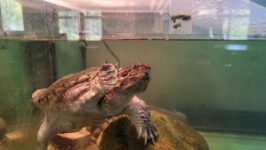
Whitehouse Nature Center’s Animal Ambassadors’ Update – The Albion College Pleiad Online

The Whitehouse Nature Center’s (WNC) visitor center, sitting on the bank of the Kalamazoo River, has been home to several reptiles and amphibians throughout its history. These animals serve as representatives of the Albion community’s environmental history and natural resources.
As of now many of the animal enclosures within the visitors center’s facilities sit empty, with two tanks housing the two remaining animals.
Only two turtles remain at the center out of the previous six: Miranda, also known as Snappy, the 15-year-old Common Snapping Turtle and Red, the 23-year-old Red-Eared Slider. These two were deemed not viable for release and now serve, according to signage in the visitor center, as the WNC’s “animal ambassadors.”
According to documents next to the turtle’s cages provided by the WNC, “Miranda was not released due to a developed condition called metabolic bone disease (MBD), which formed after being raised in captivity – an environment lacking proper UV exposure and an adequate diet. Though she is 15, Snappy is the size of a two to three-year-old wild turtle.”
According to informational flyers in the visitor center, Red can’t be released because red-eared sliders are considered invasive in many parts of the world, as they often outcompete native species.
The changes to the turtles’ housing at the center were decided at the end of the spring 2024 semester after administration members and outside entities took a look into the visitor center’s functioning, Webster said.
In March Marc Roy, professor of biology and head chair of Albion College’s Institutional Animal Care and Use Committee (IACUC), said the committee has no role in regulating animal care at the WNC. Roy said this was because the center is an autonomous institution on campus, and determines its own rules and regulations.
In April, the IACUC and the Office of the Provost provided recommendations to the WNC on prioritizing the overall well-being of the animals, according to Webster.
“The provost’s office got together with some experts and administration members and did an assessment with the director, to look into the care process for the animals and how they were recording that,” Webster said. “As well as how they were adhering to policies and procedures, and during the process thought about the state of some of the animals.”
Webster added that the main focus of the assessment was focused on the animal’s well-being and the center’s ability to care for them.
“We were interested in seeing if there were places that were better qualified to care for those animals’ day-to-day,” Webster said.
According to new signage in the visitor’s center, WNC staff worked with Wildside Rehabilitation Center and “a local Herpetologist,” who specializes in the study of reptiles and amphibians, to determine a plan for the turtles.
These professionals, the local herpetologist and individuals from Wildside Rehabilitation, said that the three box turtles, Sid, Elvira and Sheldon as well as the painted turtle Agatha were all healthy and viable for soft release, a controlled introduction and rehabilitative approach for the animals to be released back into their environment.

According to signage at the center, as animal ambassadors, the remaining animal residents “connect us with nature. They help visitors learn about the amazing diversity of wildlife and the importance of protecting natural habitats.”
In addition, the information provided within the WNC visitor center said that these turtles will need to stay in the center or within human care for the rest of their lives.



